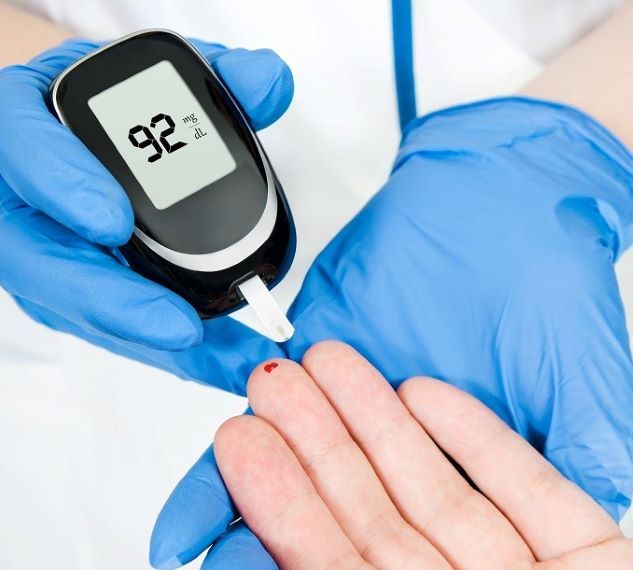Diagnosis

Quick links to our articles on the topic:
Blood sugar test: The unit of measure for blood sugar results measured from venous blood is millimoles/liter (mmol/l). Diabetes is indicated if blood sugar measured at any time of the day shows a value above 11.1 mmol/l. It is also advisable to determine the fasting blood sugar level in the morning, on an empty stomach (that is, after a 10-hour fast) using the above-mentioned method. In diabetes, this value is above 7 mmol/l, so the diagnosis of diabetes can be established.
Urinalysis: Urine normally does not contain glucose. If sugar is found in your urine, a diagnosis of glucosuria (excretion of sugar in the urine) can be made, which is, with few exceptions, evidence of diabetes.
OGTT: The oral glucose tolerance test (colloquially known as "sugar load") shows if your body has problems processing sugar. The OGTT test is recommended in case of elevated fasting blood sugar level or the presence of some risk factor. Before taking the test, you must fast for 8-12 hours and avoid certain medications. As a first step, they will take blood from you, from which the blood sugar level will be determined in the laboratory. After that, your task will be to drink a solution containing 75 grams of glucose dissolved in a glass of water, which is often not easy, as the sugar solution is very sweet. You can alleviate this by adding a few drops of freshly squeezed lemon juice. Blood will also be taken from you after 120 minutes to re-determine your blood sugar level. It is important that you exercise as little as possible during the 2-hour duration of the examination, as this may affect the result. We recommend that you take an interesting book or newspaper with you, or listen to music while sitting in a comfortable armchair. The test shows if you have IFG (increased fasting glucose), IGT (increased glucose tolerance), or diabetes.
A non-diabetic person's blood sugar values will be as follows (normal glucose tolerance):
- fasting blood sugar: ≤ 6 mmol/l
- blood sugar values 2 hours after exercise: <7.8 mmol/l
A diagnosis of IFG can be made if:
- fasting blood sugar: 6.16.9 mmol/l
- blood sugar values 2 hours after exercise: <7.8 mmol/l
IGT exists for the following values:
- fasting blood sugar: 6-7 mmol/l
- blood sugar values 2 hours after exercise: 7.8-11 mmol/l
Diabetes can be diagnosed with the following blood sugar levels:
- fasting blood sugar: >7 mmol/l
- blood sugar values 2 hours after exercise: >11 mmol/l

Detection of HbA 1c in blood: HbA 1c (pronounced: hemoglobin-á-ey-cé), i.e. glycosylated hemoglobin, shows the extent to which sugar is bound to the hemoglobin molecule that transports oxygen in the red blood cells of our blood. The higher the blood sugar level and the longer this elevated value remains, the more hemoglobin subunits bind sugar. Since the lifespan of red blood cells is approximately 90 days, the test reflects the average blood sugar values of the last 2-3 months. The test takes place as part of a traditional blood test. The measurement of HbA 1c can be used not only for establishing a diagnosis, but also for monitoring the disease. When caring for diabetic patients, it is recommended to measure HbA 1c 2-4 times a year. In healthy people, the HbA 1c value is between 4-6%. A value between 6-6.4% supports the diagnosis of prediabetes, and a value above 6.5% supports the diagnosis of diabetes. In the case of diabetes, we set an individual HbA 1c target value for patients, which ranges between 6-8%. Expectant mothers with diabetes should reduce their HbA 1c value below 6% as early as possible when planning pregnancy, which is recommended to be maintained until the end of pregnancy.
It is important to understand that HbA 1c is not the same as the blood sugar level you check at home! The table below shows the average self-monitored blood sugar values that correspond to the results of the HbA 1c test. If the HbA 1c value is 7%, it means that your blood sugar level averaged 8.2 mmol/l over 2-3 months. It is recommended that you strictly pay attention to keeping your blood sugar level as close as possible to the target value during care, as this can prevent many health problems or postpone their occurrence until later in life.
|
HbA 1c value % |
Average blood sugar level |
|
14.0 |
21.1 |
|
13.0 |
19.3 |
|
12.0 |
17.4 |
|
11.0 |
15.6 |
|
10.0 |
13.7 |
|
9.0 |
11.9 |
|
8.0 |
10.0 |
|
7.0 |
8.2 |
|
6.0 |
6.3 |
|
5.0 |
4.7 |
|
4.0 |
2.6 |
Other laboratory tests
- Ketone bodies (e.g. beta-hydroxylbutyrate, acetoacetate, acetone) build up in the blood and are excreted in the urine: This happens because the body tries to get energy by producing these substances in the absence of glucose.
- C-peptide: C-peptide is released from the pancreas to the same extent as when insulin is produced. Measuring C-peptide helps distinguish type 1 diabetes (absolute insulin deficiency: low or absent C-peptide) from type 2 (insulin resistance: high C-peptide).
Read more about diabetes by clicking on the buttons below!
If you have any questions, book an appointment and contact our diabetologists:
